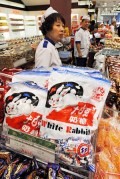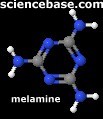 Before you check out the following items, please click here first to grab the Sciencebase newsfeed. I’ll be updating the melamine news over the next few days, and the RSS newsfeed system allows you to keep up to date with the Sciencebase site without having to check back by adding our headlines to your Google account, My Yahoo, Bloglines or your active bookmarks in your browser.
Before you check out the following items, please click here first to grab the Sciencebase newsfeed. I’ll be updating the melamine news over the next few days, and the RSS newsfeed system allows you to keep up to date with the Sciencebase site without having to check back by adding our headlines to your Google account, My Yahoo, Bloglines or your active bookmarks in your browser.
As the melamine in milk products from China problem continues to grow apace, Sciencebase presents a succinct list of melamine contaminated food list culled from the most recent news results on the subject. This is by no means an exhaustive list nor is it a condemnation of any particular products, it’s here merely to raise awareness of what is happening with regard to the melamine in milk scandal.
- Powdered baby milk.
- HK finds melamine in Chinese-made cheesecake.
- Cookies With Melamine Found in Netherlands.
- Mr Brown coffee products.
- Manufacturing giant Unilever recalls melamine tainted tea. CNN is also reporting that the Hong Kong authorities Sunday (October 5) announced that two recalled candy products made by British confectioner Cadbury had high levels of melamine.
- Melamine Detected in Two More Ritz Snacks.
- More Chinese-made sweets recalled in Japan.
- White Rabbit brand Chinese candy contaminated: Asian health officials.
- Lipton, Glico and Ritz the latest businesses to be affected by milk powder scandal.
- Hong Kong finds traces of melamine in Cadbury products.
- Recalled Melamine Milk Products include Asian versions of Bairong grape cream crackers, Dove chocolate, Dreyers cake mix, Dutch Lady candy, First Choice crackers, Kraft Oreo wafer sticks, M&Ms, Magnum ice cream, Mentos bottle yoghurt, Snickers funsize, Yili hi-cal milk, Youcan sesame snacks and others. Testing of some of those has already proven negative.
- Melamine Found in More China-Made Products, including Heinz DHA+AA baby cereal.
- 305 Chinese dairy-based products temporarily banned in Korea.
- US bloggers have gone so far as to uncover dozens of products recalled in China that were still on the shelves of their local supermarkets.
- 31 new milk powder brands found tainted.
Just for the record, this is not, as was suggested on a couple of blogs linking here, a definitive, complete list. I will update it as and when new information comes to light. Check out the previous posts for more information in the background to this news story and for further discussion on the issues surrounding the melamine in milk products scandal: Melamine Scandal Widens and (2008-09-29) Milky Melamine.
 I’m not sure what to make of this, but Don Mueller, of William Paterson University, New Jersey, who goes by the nickname Dr Bones sent me some video clips of what is, essentially, a new sport he invented – two-racquet tennis. Now, my first thought was: “what the flip?” But, apparently his service velocity is higher than that of most tennis professionals, although I don’t think that has anything to do with using a racquet in each hand.
I’m not sure what to make of this, but Don Mueller, of William Paterson University, New Jersey, who goes by the nickname Dr Bones sent me some video clips of what is, essentially, a new sport he invented – two-racquet tennis. Now, my first thought was: “what the flip?” But, apparently his service velocity is higher than that of most tennis professionals, although I don’t think that has anything to do with using a racquet in each hand. A brief summary and
A brief summary and  Gossip and rumours, they are the life force of cultural interaction. Just ask Guy Kawasaki, whose Truemors.com website took off last year, the hundreds of hacks who peddle the minutiae of celebrity lifestyles complete with the Photoshopped products of the paparazzi, or
Gossip and rumours, they are the life force of cultural interaction. Just ask Guy Kawasaki, whose Truemors.com website took off last year, the hundreds of hacks who peddle the minutiae of celebrity lifestyles complete with the Photoshopped products of the paparazzi, or  This week in my SpectroscopyNOW column, I have four new posts covering, as usual, a wide range of solutions to scientific and technical problems. First up, is the discovery that compounds found in cannabis could lead to novel antibiotics that are less susceptible to resistance than conventional drugs. Then, we have a new type of spectroscopy that allows scientists to carry out broadband analysis of artificial atoms held at temperatures close to absolute zero. Next, is word from chemists that they have developed a new type of reaction flask that can carry out reactions in the solid state. Finally, this week, we hear of testing times for biomass, where modern spectral analysis could help in the processing of old, treated wood as a renewable fuel resource.
This week in my SpectroscopyNOW column, I have four new posts covering, as usual, a wide range of solutions to scientific and technical problems. First up, is the discovery that compounds found in cannabis could lead to novel antibiotics that are less susceptible to resistance than conventional drugs. Then, we have a new type of spectroscopy that allows scientists to carry out broadband analysis of artificial atoms held at temperatures close to absolute zero. Next, is word from chemists that they have developed a new type of reaction flask that can carry out reactions in the solid state. Finally, this week, we hear of testing times for biomass, where modern spectral analysis could help in the processing of old, treated wood as a renewable fuel resource. Four infants in China have died and at least 53,000 are reportedly ill, many seriously so, having been fed milk powder contaminated with the industrial chemical
Four infants in China have died and at least 53,000 are reportedly ill, many seriously so, having been fed milk powder contaminated with the industrial chemical  It is becoming apparent that contaminated baby formula is not the only problem. Milk, ice cream, yoghurt, confectionery such as chocolates, biscuits and sweets, as well as any foods containing milk from China have been banned from import into Singapore after the country’s agri-food and veterinary authority found melamine in imported samples. Similarly, Taiwanese authorities seized imported products after notification of contamination from Beijing earlier this month. Japan has recalled various products. Canada’s Food Inspection Agency has warned citizens not to eat a dessert – Nissin Cha Cha Dessert – imported from China that has been found to be contaminated with melamine. The authorities in the Philippines are currently testing.
It is becoming apparent that contaminated baby formula is not the only problem. Milk, ice cream, yoghurt, confectionery such as chocolates, biscuits and sweets, as well as any foods containing milk from China have been banned from import into Singapore after the country’s agri-food and veterinary authority found melamine in imported samples. Similarly, Taiwanese authorities seized imported products after notification of contamination from Beijing earlier this month. Japan has recalled various products. Canada’s Food Inspection Agency has warned citizens not to eat a dessert – Nissin Cha Cha Dessert – imported from China that has been found to be contaminated with melamine. The authorities in the Philippines are currently testing. Today, is the first day of autumn, the fall, and Google is celebrating with a new leafy logo. But, why do leaves turn red in the fall? It’s all down to chemistry. Red pigments known as anthocyanins form in leaves from many plant and tree species at the same time as the green photosynthetic apparatus is dismantled by the plant. During this process nutrients containing nitrogen (N) and phosphorus (P) are re-absorbed by the plant from its leaves for winter storage and the plant’s waste products in the leaves are left behind. If these nutrients are not resorbed next year’s growth is inhibited. As the levels of green compounds in the leaf falls and anthocyanins rise so the leaves of many species change from verdant to rusty with a range of colours in between. In one sense (according to my high school biology teacher, Mrs Bradley [no relation], the trees are “urinating”, or more strictly, excreting waste in the annual fall.
Today, is the first day of autumn, the fall, and Google is celebrating with a new leafy logo. But, why do leaves turn red in the fall? It’s all down to chemistry. Red pigments known as anthocyanins form in leaves from many plant and tree species at the same time as the green photosynthetic apparatus is dismantled by the plant. During this process nutrients containing nitrogen (N) and phosphorus (P) are re-absorbed by the plant from its leaves for winter storage and the plant’s waste products in the leaves are left behind. If these nutrients are not resorbed next year’s growth is inhibited. As the levels of green compounds in the leaf falls and anthocyanins rise so the leaves of many species change from verdant to rusty with a range of colours in between. In one sense (according to my high school biology teacher, Mrs Bradley [no relation], the trees are “urinating”, or more strictly, excreting waste in the annual fall. For more information on why leaves turn red in autumn, check out this page from Wisconsin University.
For more information on why leaves turn red in autumn, check out this page from Wisconsin University.  Chernobyl. The very name strikes fear into the hearts of those who hate everything about the nuclear industry. It conjures up images of an archaic, burning industrial site spewing out lethal fumes, of farm animals dying of radiation poisoning in their thousands and contaminated meat, of ecosystems devastated, and of people with radiation sickness and for those spared the acutely fatal toxicity, the prospect of cancers to come and perhaps generations of mutations. But…
Chernobyl. The very name strikes fear into the hearts of those who hate everything about the nuclear industry. It conjures up images of an archaic, burning industrial site spewing out lethal fumes, of farm animals dying of radiation poisoning in their thousands and contaminated meat, of ecosystems devastated, and of people with radiation sickness and for those spared the acutely fatal toxicity, the prospect of cancers to come and perhaps generations of mutations. But… UPDATE:
UPDATE:  Melamine is an organic compound, a base with the formula C3H6N6. Officially it is 1,3,5-triazine-2,4,6-triamine in the IUPAC nomenclature system (CAS #108-78-1). It is has a molecular mass of just over 126, forms a white, crystalline powder, and is only slightly soluble in water. It is used in fire retardants in polymer resins because its high nitrogen content is released as flame-stifling nitrogen gas when the compound is burned or charred.
Melamine is an organic compound, a base with the formula C3H6N6. Officially it is 1,3,5-triazine-2,4,6-triamine in the IUPAC nomenclature system (CAS #108-78-1). It is has a molecular mass of just over 126, forms a white, crystalline powder, and is only slightly soluble in water. It is used in fire retardants in polymer resins because its high nitrogen content is released as flame-stifling nitrogen gas when the compound is burned or charred. As a kind of follow-up to my
As a kind of follow-up to my